Hydrogenation Catalysts

Hydrogenation is a very common reaction in which H2 can be introduced through double or triple bonds and is widely used in both laboratory and industrial production. This reaction usually requires the presence of metal catalysts in order to carry out, in the presence of such catalysts, it is called catalytic reduction or catalytic hydrogenation. These reaction conditions are also applicable to the deprotection of phenyl and phenoxycarbonyl groups.
The hydrogenation catalysts include heterogeneous catalysts such as palladium/charcoal (Pd/C); Homogeneous catalysts, such as Wilkinson catalysts, as well as asymmetric hydrogenation catalysts, are used in many cases. This article mainly summarizes various hydrogenation catalysts.
Catalysts for Hydrogenation
Catalytic reduction is widely used for hydrogenation of carbon-carbon bonds, reduction of nitro, and removal of phenyl and phenoxycarbonyl groups.1?Platinum is used in many forms, such as Pd/C co-catalysts, as well as Wilkinson catalysts [W106045]2-4?and Crabtree catalysts [C130061].5?Both Wilkinson catalyst and Crabtree catalyst can selectively hydrogenate olefins and alkynes. In addition, due to its coordination functional groups, Crabtree catalyst also has the effect of stereoselective hydrogenation.6


1. Shvo Catalyst
Shvo's team reported a ruthenium binuclear complex [H121109] that uses formic acid as a hydrogen source to catalyze the hydrogenation of carbonyl and olefin molecules.7?When α, β-unsaturated ketones are reduced by Shvo catalyst, the olefin portion is selectively hydrogenated.

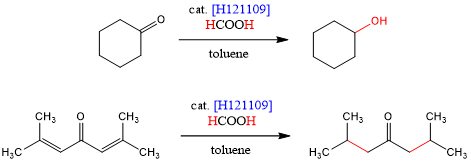
2. Ruthenium-complex Catalyst
The ruthenium catalyst [C282669] can reduce the ester to alcohol. Under such reaction conditions, a wide range of solvents can be selected, and hydrogenation can be performed even under simple conditions.8?Under such conditions, however, some benzyl and phenoxycarbonyl groups that would normally be removed under normal conditions are retained. In addition, [C282669] catalyst can also hydrogenate aldehydes, amides and nitriles.?9


3. Manganese-complex Catalyst
Beller's group reported that the manganese complex [B405322] is a very helpful catalyst for nitrile hydrogenation.10?The complex can also catalyze the reduction of ketones by hydrogen atoms transferred from isopropyl alcohol.11
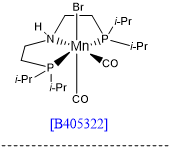
4. Rhodium Catalyst for cis-Selective?Hydrogenation of Aromatic Rings
(Cyclohexyl-CAAC)Rh(COD)Cl [C405717] is used as an efficient?and selective aromatic hydrogenation catalysts owning from the?strongly σ-donating ligand. C405717?can be used for the synthesis?of cyclohexane moieties while still retaining various functional?groups like carbonyls,12?silyls,13?and boryls14?in a single step.?Under these conditions, the cis-configured saturated hydrocarbon?is selectively provided.

5. Organocatalysts for Metal-free?Hydrogenations
1,8-bis (diphenylphosphine) naphthalene [B152147] contains two diphenylphosphino groups and is a common macromolecular Lewis base. The volume of B152147?can also be effectively treated with a Lewis acid similar to tris(pentafluorophenyl)borane [T109495] to form unquenched Lewis acid-base pairs, "hindered Lewis pairs (FLPs)". Erker et al.?have applied them to activate hydrogen molecules and perform metal-free hydrogenation reactions with silenol ethers. In this reaction, hydrogen molecules are activated by acid-base synergies induced by FLP.15

Catalysts for Asymmetric Hydrogenation
Noyori et al.?reported that metal complexes with chiral 2,2'-bis (diphenylphosphine)-1,1'-dinaphthyl (BINAP) ligands can be used as catalysts for partial asymmetric hydrogenation of olefin with high yield and enantioselectivity.16, 17 This method has been used to make aromatic chemicals and drugs.
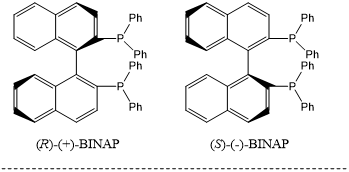

Catalysts containing BINAP fragments have a high conversion rate (TON), and the TON value of catalysts such as C282701?can reach 100,000.?18?Currently, researchers have developed several types of BINAP analogues. Similarly, catalyst D282716?has been used for asymmetric amination reactions and the reduction of ketones and olefins.19

Ikariya et al.?have reported an asymmetric hydrogenation using?formic acid salt [F156751] as a proton source and ruthenium?catalysts with a chiral diamine ligand [N282693] [N282692].20?Conventional catalysts have often required high pressure?conditions, but these catalysts can hydrogenate substances?under atmospheric pressure requiring no special apparatuses.

References
1) review: a) R. E. Harmon, S. K. Gupta, D. J. Brown, Chem. Rev. 1973, 73, 21.?https://doi.org/10.1021/cr60281a003
b) B. R. James, Adv. Organomet. Chem. 1979, 17, 319. https://doi.org/10.1039/IC9797600189
c) H.-U. Blaser, Christophe, M. B. Pugin, F. Spindler, H. Steiner, M. Studer, Adv. Synth. Catal. 2003, 1-2, 103.?https://doi.org/10.1021/ja7102422
2) J. F. Young, J. A. Osborn, F. H. Jardine, G. Wilkinson, Chem. Commun. 1965, 131. https://doi.org/10.1039/C19650000131
3) J. A. Osborn, F. H. Jardine, J. F. Young, G. Wilkinson, J. Chem. Soc. A 1966, 1711. https://doi.org/10.1039/J19660001711
4) S. Mahboobi, K. Bernauer, Helv. Chim. Acta 1988, 71, 2034. https://doi.org/10.1016/0957-4166(94)80122-3
5) R. H. Crabtree, M. W. Davis, J. Org. Chem. 1986, 51, 2655. https://doi.org/10.1021/jo00364a007
6) R. H. Crabtree, M. W. Davis, Organometallics 1983, 2, 681. https://doi.org/10.1016/0022-328X(88)83154-1
7) N. Menashe, E. Salant, Y. Shvo, J. Organomet. Chem. 1996, 514, 97. https://www.sciencedirect.com/journal/journal-of-organometallic-chemistry/vol/514/issue/1
8) W. Kuriyama, T. Matsumoto, O. Ogata, Y. Ino, K. Aoki, S. Tanaka, K. Ishida, T. Kobayashi, N. Sayo, T. Saito, Org. Process Res. Dev. 2012, 16, 166. https://doi.org/10.1021/op200234j
9) J. Neumann, C. Bornschein, H. Jiao, K. Junge, M. Beller, Eur. J. Org. Chem. 2015, 27, 5944.?https://doi.org/10.1002/ejoc.201501007
10) S. Elangovan, C. Topf, S. Fischer, H. Jiao, A. Spannenberg, W. Baumann, R. Ludwig, K. Junge, M. Beller, J. Am. Chem. Soc. 2016, 138, 8809. https://doi.org/10.1021/jacs.6b03709
11) M. Perez, S. Elangovan, A. Spannenberg, K. Junge, M. Beller, ChemSusChem 2017, 10, 83. https://doi.org/10.1002/cssc.201601057
12) Y. Wei, B. Rao, X. Cong, X. Zeng, J. Am. Chem. Soc. 2015, 137, 9250. https://doi.org/10.1021/jacs.5b05868
13) M. P. Wiesenfeldt, T. Knecht, C. Schlepphorst, F. Glorius, Angew. Chem. Int. Ed. 2018, 57, 8297. https://doi.org/10.1002/anie.201804124
14) M. Wollenburg, D. Moock, F. Glorius, Angew. Chem. Int. Ed. 2018, 57, 1. https://onlinelibrary.wiley.com/toc/15213773/2018/57/1
15) H. Wang, R. Fr?hlich, G. Kehr, G. Erker, Chem. Commun. 2008, 5966. https://doi.org/10.1039/B813286K
16) A. Miyashita, A. Yasuda, H. Takaya, K. Toriumi, T. Ito, T. Souchi, R. Noyori, J. Am. Chem. Soc. 1980, 102, 7932. https://doi.org/10.1021/ja00547a020
17) T. Ohta, H. Takaya, M. Kitamura, K. Nagai, R. Noyori, J. Org. Chem. 1987, 52, 3174. https://doi.org/10.1021/jo00390a043
18) K. Matsumura, N. Arai, K. Hori, T. Saito, N. Sayo, T. Ohkuma, J. Am. Chem. Soc. 2011, 133, 10696. https://doi.org/10.1021/ja202296w
19) G. F. Busscher, L. Lefort, J. G. O. Cremers, M. Mottinelli, R. W. Wiertz, B. de Lange, Y. Okamura, Y. Yusa, K. Matsumura, H. Shimizu, J. G. de Vries, A. H. M. de Vries, Terahedron: Asymm. 2010, 21, 1709. https://doi.org/10.1016/j.tetasy.2010.04.013
20) T. Touge, T. Hakamata, H. Nara, T. Kobayashi, N. Sayo, T. Saito, Y. Kayaki, T. Ikariya, J. Am. Chem. Soc. 2011, 133, 14960. https://doi.org/10.1021/ja207283t
 首页
首页 400-620-6333
400-620-6333



 危险品化学品经营许可证(带存储)
危险品化学品经营许可证(带存储)